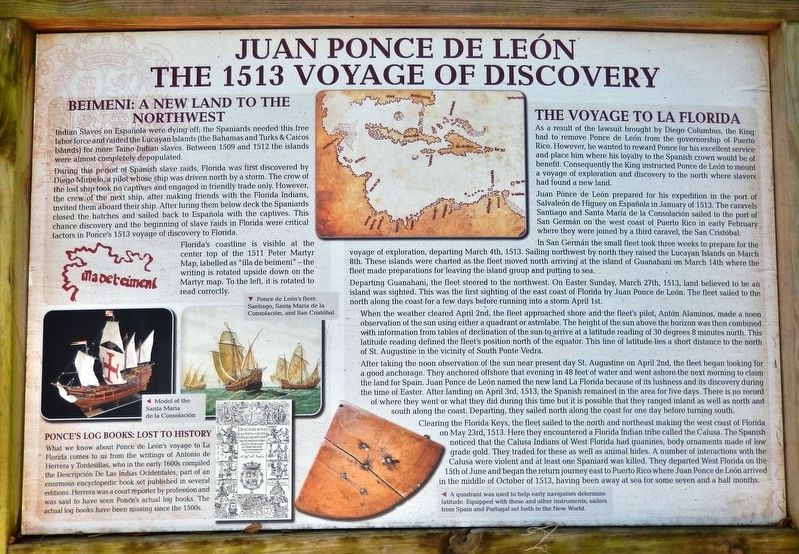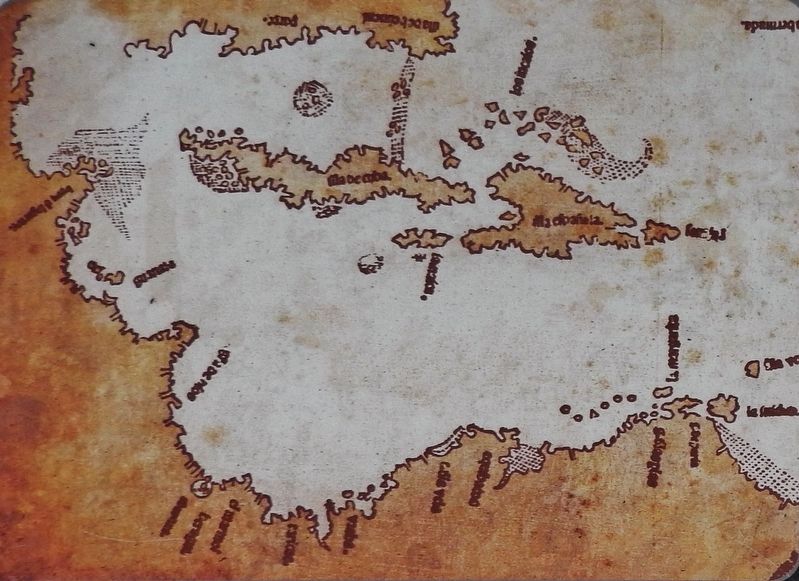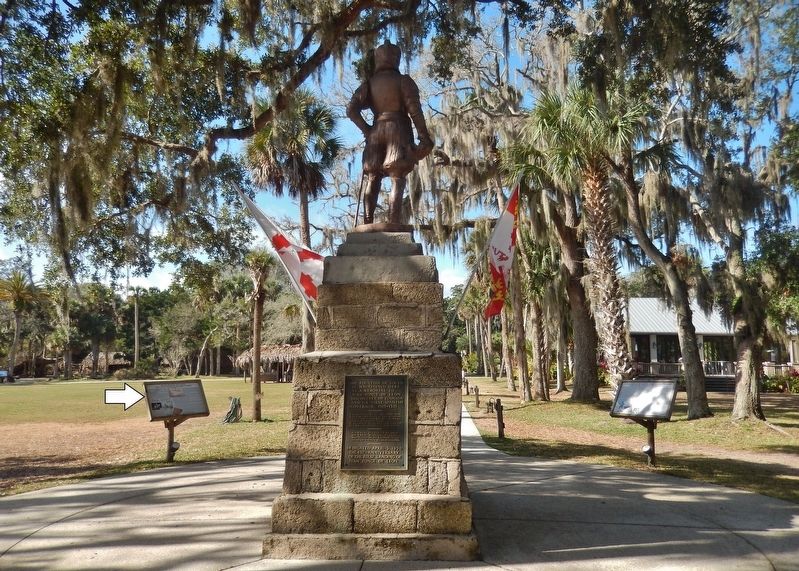Historic District in St. Augustine in St. Johns County, Florida — The American South (South Atlantic)
Juan Ponce De León
The 1513 Voyage of Discovery
Beimeni: A New Land to the Northwest
Indian Slaves on Española were dying off; the Spaniards needed this free labor force and raided the Lucayan Islands (the Bahamas and Turks & Caicos Islands) for more Taino Indian slaves. Between 1509 and 1512 the islands were almost completely depopulated.
During this period of Spanish slave raids, Florida was first discovered by Diego Miruelo, a pilot whose ship was driven north by a storm. The crew of the lost ship took no captives and engaged in friendly trade only. However, the crew of the next ship, after making friends with the Florida Indians, invited them aboard their ship. After luring them below deck the Spaniards closed the hatches and sailed back to Española with the captives. This chance discovery and the beginning of slave raids in Florida were critical factors in Ponce's 1513 voyage of discovery to Florida.
Florida's coastline is visible at the center top of the 1511 Peter Martyr Map, labelled as "illa de beimeni" — the writing is rotated upside down on the Martyr map. To the left, it is rotated to read correctly.
Ponce’s Log Books: Lost to History
What we know about Ponce de León’s voyage to La Florida comes to us from the writings of Antonio de Herrera y Tordesillas, who in the early 1600s compiled the Descripción De Las Indias Ocidentales, part of an enormous encyclopedic book set published in several editions. Herrera was a court reporter by profession and was said to have seen Ponce's actual log books. The actual log books have been missing since the 1500s.
The Voyage to La Florida
As a result of the lawsuit brought by Diego Columbus, the King had to remove Ponce de León from the governorship of Puerto Rico. However, he wanted to reward Ponce for his excellent service and place him where his loyalty to the Spanish crown would be of benefit. Consequently the King instructed Ponce de León to mount a voyage of exploration and discovery to the north where slavers had found a new land.
Juan Ponce de León prepared for his expedition in the port of Salvaleón de Higuey on Española in January of 1513. The caravels Santiago and Santa Maria de la Consolación sailed to the port of San Germán on the west coast of Puerto Rico in early February where they were joined by a third caravel, the San Cristóbal.
In San Germán the small fleet took three weeks to prepare for the voyage of exploration, departing March 4th, 1513. Sailing northwest by north they raised the Lucayan Islands on March 8th. These islands were charted as the fleet moved north arriving at the island of Guanahani on March 14th where the fleet made preparations for leaving the island group and putting to sea.
Departing Guanahani, the fleet steered to the northwest. On Easter Sunday, March 27th, 1513, land believed to be an island was sighted. This was the first sighting of the east coast of Florida by Juan Ponce de León. The fleet sailed to the north along the coast for a few days before running into a storm April 1st.
When the weather cleared April 2nd, the fleet approached shore and the fleet's pilot, Antón Alaminos, made a noon observation of the sun using either a quadrant or astrolabe. The height of the sun above the horizon was then combined with information from tables of declination of the sun to arrive at a latitude reading of 30 degrees 8 minutes north. This latitude reading defined the fleet's position north of the equator. This line of latitude lies a short distance to the north of St. Augustine in the vicinity of South Ponte Vedra.
After taking the noon observation of the sun near present day St. Augustine on April 2nd, the fleet began looking for a good anchorage. They anchored offshore that evening in 48 feet of water and went ashore the next morning to claim the land for Spain. Juan Ponce de León named the new land La Florida because of its lushness and its discovery during the time of Easter. After landing on April 3rd, 1513, the Spanish remained in the area for five days. There is no record of where they went or what they did during this time but it is possible that they
ranged inland as well as north and south along the coast. Departing, they sailed north along the coast for one day before turning south.
Clearing the Florida Keys, the fleet sailed to the north and northeast making the west coast of Florida on May 23rd, 1513. Here they encountered a Florida Indian tribe called the Calusa. The Spanish noticed that the Calusa Indians of West Florida had guanines, body ornaments made of low grade gold. They traded for these as well as animal hides. A number of interactions with the Calusa were violent and at least one Spaniard was killed. They departed West Florida on the 15th of June and began the return journey east to Puerto Rico where Juan Ponce de León arrived in the middle of October of 1513, having been away at sea for some seven and a half months.
[photo captions]
• Ponce De León’s fleet: Santiago, Santa Maria de la Consolación, and San Cristóbal
• Model of the Santa Maria de la Consolación
• A quadrant was used to help early navigators determine latitude. Equipped with these and other instruments, sailors from Spain and Portugal set forth to the New World.
Topics. This historical marker is listed in these topic lists: Colonial Era • Exploration • Native Americans • Waterways & Vessels. A significant historical date for this entry is April 3, 1513.
Location. 29° 54.418′ N, 81°
18.861′ W. Marker is in St. Augustine, Florida, in St. Johns County. It is in the Historic District. Marker can be reached from Williams Street east of Magnolia Avenue when traveling east. Marker is located along the interpretive trail in Ponce de León's Fountain of Youth Archaeological Park. Touch for map. Marker is at or near this postal address: 11 Magnolia Avenue, Saint Augustine FL 32084, United States of America. Touch for directions.
Other nearby markers. At least 8 other markers are within walking distance of this marker. Juan Ponce De Leon (here, next to this marker); The Fountain of Youth (here, next to this marker); a different marker also named Juan Ponce De León (here, next to this marker); a different marker also named Juan Ponce De León (a few steps from this marker); a different marker also named Juan Ponce De León (a few steps from this marker); The Matchlock Arquebus (within shouting distance of this marker); Archaeology of the Menéndez Encampment (within shouting distance of this marker); The Menéndez Settlement Field (within shouting distance of this marker). Touch for a list and map of all markers in St. Augustine.
Related markers. Click here for a list of markers that are related to this marker. Ponce de León's Fountain of Youth Archaeological Park
Credits. This page was last revised on December 29, 2021. It was originally submitted on December 20, 2021, by Cosmos Mariner of Cape Canaveral, Florida. This page has been viewed 220 times since then and 15 times this year. Photos: 1, 2, 3, 4. submitted on December 21, 2021, by Cosmos Mariner of Cape Canaveral, Florida.



